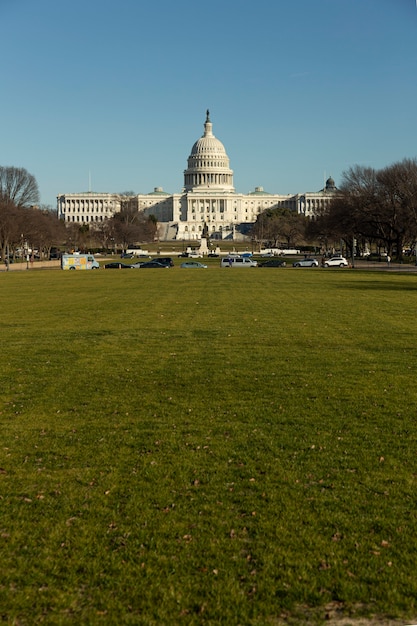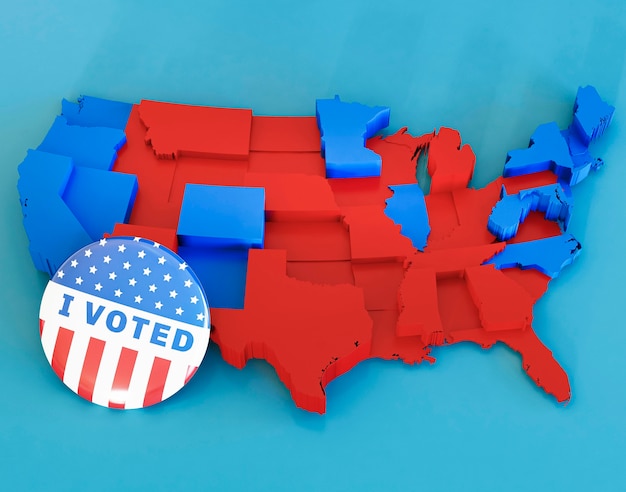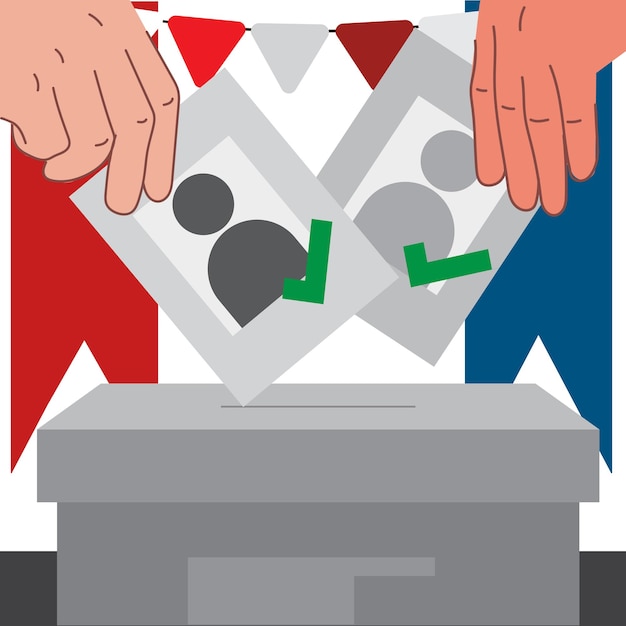Electoral College Reform: Unpacking the Debate and Future Prospects

Understanding the Current Debate Over Electoral College Reform: Is Change on the Horizon? involves analyzing arguments for and against the current system, exploring potential alternative models, and assessing the political feasibility of amending or replacing the Electoral College in the United States.
The understanding the current debate over Electoral College reform: is change on the horizon? is a crucial question in modern American politics, given the system’s controversial history and impact on election outcomes. Many propose amendments to ensure a more democratic representation of the popular vote, while others staunchly defend the Electoral College as vital for preserving the balance of power between states.
Electoral College: A Historical Overview
The Electoral College, established by the U.S. Constitution, determines how presidents are elected. It’s not a college in the academic sense, but a process involving the selection of electors who then cast votes for president and vice president. Understanding its origins helps clarify the current debates.
Founding Fathers’ Intentions
The Founding Fathers created the Electoral College as a compromise between a popular vote election and a congressional election of the president. They aimed to balance the power of more populous states with that of less populous ones, fearing pure democracy could lead to “tyranny of the majority.”
Evolution Over Time
Over time, the Electoral College system evolved. Originally, electors could cast votes for any candidate, but the rise of political parties shifted this. By the 19th century, most electors pledged to vote for their party’s nominee, making the system more predictable, but also sparking debates about its fairness.
- 1800 Election: A tie between Thomas Jefferson and Aaron Burr led to the 12th Amendment, which required electors to cast separate votes for president and vice president.
- Post-Civil War Amendments: The 14th and 15th Amendments altered how populations were counted, affecting representation in the Electoral College.
- Modern Debates: Contemporary discussions often revolve around whether the Electoral College still reflects the Founders’ intentions or whether it needs further reform.
The history of the Electoral College shows a system that has continually adapted but still faces fundamental questions about representation and fairness.

Arguments For and Against the Electoral College
The debate over whether to keep or abolish the Electoral College is fueled by strong arguments on both sides. Defenders emphasize its role in protecting less populous states, while critics argue it undermines the principle of “one person, one vote.”
Arguments in Favor
Supporters of the Electoral College contend that it prevents candidates from focusing solely on densely populated areas, forcing them to campaign broadly across the country. They also argue that it ensures all states have a voice in presidential elections, preventing a “tyranny of the majority” where a few large cities could decide the outcome.
Arguments Against
Critics argue that the Electoral College distorts the popular vote, leading to situations where a candidate can win the presidency without winning the popular vote, as happened in 2000 and 2016. This, they say, undermines democratic principles and leads to voter disenfranchisement, particularly in states where the outcome is perceived as predetermined.
- Disproportionate Representation: Smaller states have more electoral votes per capita than larger states, giving their residents greater influence in presidential elections.
- Swing State Focus: Candidates often concentrate their resources on a few swing states, ignoring voters in states where the outcome is predictable.
- Voter Turnout: Some studies suggest that the Electoral College depresses voter turnout, as voters in non-swing states may feel their votes don’t matter.
The arguments for and against the Electoral College reflect deep divisions about representation, fairness, and the very nature of democracy in the United States.
Exploring Alternative Electoral Models
Proposals to reform or replace the Electoral College vary widely, each aiming to address specific concerns about fairness and representation. Here are some of the most discussed alternatives.
National Popular Vote Interstate Compact
This agreement among states commits them to awarding their electoral votes to the candidate who wins the national popular vote. It would only take effect once states representing at least 270 electoral votes join the compact, effectively guaranteeing the national popular vote winner becomes president.
Proportional Allocation of Electoral Votes
Instead of awarding all electoral votes to the candidate who wins a state’s popular vote (winner-take-all), states could allocate electoral votes proportionally based on the percentage of the vote each candidate receives. This could lead to more competitive elections and better reflect the popular vote within each state.
Ranked-Choice Voting
In a ranked-choice voting system, voters rank candidates in order of preference. If no candidate receives a majority of first-choice votes, the candidate with the fewest votes is eliminated, and their votes are redistributed to the voters’ second choices. This process continues until a candidate receives a majority, ensuring the winner has broader support.

The Roadblocks to Electoral College Reform
Despite ongoing debates and proposed reforms, changing the Electoral College is a formidable challenge. The process is fraught with legal, political, and constitutional hurdles.
Constitutional Amendment Process
Amending the Constitution requires a two-thirds vote in both the House and Senate, followed by ratification by three-quarters of the states. This high threshold makes it difficult to pass any amendment, especially one as politically charged as Electoral College reform.
Political Polarization
The Electoral College debate has become increasingly partisan, with Democrats generally favoring reform and Republicans defending the current system. This polarization makes it difficult to find common ground and build the bipartisan support needed to pass any meaningful change.
Small State Resistance
Smaller states benefit from the disproportionate representation afforded by the Electoral College and are likely to resist any reforms that would diminish their influence in presidential elections. Their opposition can be a significant obstacle to achieving the necessary consensus for change.
- Legal Challenges: Any major reform is likely to face legal challenges, potentially delaying or derailing implementation.
- Public Awareness: Many Americans have a limited understanding of the Electoral College and its implications, making it difficult to mobilize public support for reform.
- Entrenched Interests: Political parties and interest groups have a vested interest in maintaining the current system, further complicating the path to reform.
The combination of these factors presents a significant challenge to those advocating for Electoral College reform, highlighting the complexity of changing a system deeply embedded in the American political landscape.
Public Opinion and the Future of the Electoral College
Public sentiment on the Electoral College is divided, often along partisan lines, and understanding these attitudes is crucial for assessing the prospects of reform.
Shifting Attitudes
Polls consistently show that a majority of Americans favor abolishing the Electoral College and electing the president by national popular vote. However, support for the Electoral College has increased among Republicans in recent years, particularly after presidential elections where the popular vote winner lost the Electoral College.
Generational Differences
Younger voters are more likely to support Electoral College reform than older voters, reflecting a broader trend of younger generations favoring more direct democracy. This generational divide could shape the future of the debate as younger voters become a larger portion of the electorate.
Impact of Recent Elections
The 2000 and 2016 presidential elections, where the popular vote winner lost the Electoral College, have intensified the debate and fueled calls for reform. These outcomes have led to increased scrutiny of the Electoral College and its impact on democratic legitimacy.
The Implications of No Reform
If efforts to reform the Electoral College continue to stall, the current system will remain in place, potentially leading to further controversies and challenges to the legitimacy of presidential elections.
Continued Disconnect
Without reform, the disconnect between the popular vote and the Electoral College outcome could persist, potentially undermining public trust in the electoral process and leading to increased political polarization.
Focus on Swing States
Candidates are likely to continue focusing their resources on a handful of swing states, ignoring voters in the vast majority of states where the outcome is perceived as predetermined. This could exacerbate feelings of disenfranchisement among voters in non-swing states.
| Key Point | Brief Description |
|---|---|
| 🗳️ Electoral College | Determines how presidents are elected in the U.S. |
| ⚖️ Proportionality | Debates center on fair representation across states. |
| 🔄 Reform Challenges | Constitutional, political, and state resistance. |
| 🌐 Public Opinion | Divided, with generational and partisan differences. |
FAQ
▼
The Electoral College is a process outlined in the U.S. Constitution for electing the president and vice president. Rather than directly voting for a candidate, citizens vote for a slate of electors who then cast the actual votes.
▼
The Founding Fathers created the Electoral College as a compromise between electing the president by popular vote and electing the president by a vote in Congress. It was meant to balance the power of populous states with that of less populous ones.
▼
Critics argue that the Electoral College can lead to a president being elected without winning the popular vote, undermining the principle of “one person, one vote.” It’s seen as giving disproportionate power to swing states.
▼
Alternatives include the National Popular Vote Interstate Compact, proportional allocation of electoral votes, and ranked-choice voting. These aim to better align the presidential election outcome with the national popular vote.
▼
Reforming the Electoral College is extremely challenging due to the high constitutional threshold for amendments, political polarization, and resistance from smaller states that benefit from the current system’s disproportionate representation.
Conclusion
In conclusion, **understanding the current debate over Electoral College reform: is change on the horizon?** is complex and multifaceted. The debates, arguments, and potential reforms highlight the ongoing tension between democratic ideals and historical realities in the American political system. While the path to reform faces significant hurdles, the continued dialogue reflects a commitment to ensuring that the electoral process is as fair and representative as possible.
